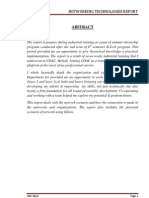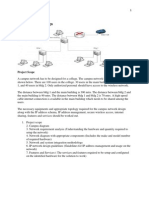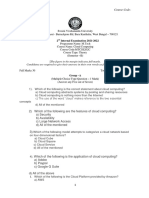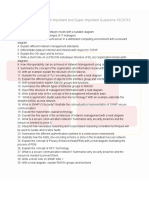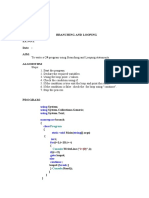DCN Project Report
DCN Project Report
Uploaded by
Nur Fatin Firzanah Mohd FauziCopyright:
Available Formats
DCN Project Report
DCN Project Report
Uploaded by
Nur Fatin Firzanah Mohd FauziOriginal Description:
Original Title
Copyright
Available Formats
Share this document
Did you find this document useful?
Is this content inappropriate?
Copyright:
Available Formats
DCN Project Report
DCN Project Report
Uploaded by
Nur Fatin Firzanah Mohd FauziCopyright:
Available Formats
SEMESTER SEPTEMBER 2016
TDB 1133
DATA COMMUNICATION AND
NETWORKING
GROUP MEMBERS NAME:
1) SYAKIRAH AIMI BINTI SUPIAN
2) NUR FATIN FIRZANAH BINTI MOHD FAUZI
3) UMEETA KAUR A/P HARBINDAR SINGH
BIS 22979
ICT 22981
ICT 23002
22979 | 22981 | 23002
Introduction
Cyber caf is giving countless benefits for people. It is providing internet for the people who seek
for internet connection, either for gaming, working or even tourist who needs it whenever theyre abroad.
Most cyber cafes have more than one computer. Think about how great it would be if these
computers could share information. When computers are connected to each other, they can share a single
printer, use a single internet connection, share files such as images, spreadsheets and documents, allow
users at different computers to play games together and send the output of a device like a DVD player or
Webcam to another computer. PCs can be connected in a variety of ways, it can be connected with wiring
the building or house with data cables, run cables across the floor between computers in the same room,
install some form of wireless network, link computer through power or phone lines and walk diskettes
back and forth between computers. However, this is inexpensive but tiresome.
Each of these methods has advantages and disadvantages. However, all (except physically
carrying diskettes between computers) require that computers be configured to share printers, files and an
Internet connection as well as be protected by a layer of security. Additionally, computer networking will
largely depend on ones budget, geographical location and available options.
To install a network, there are three basic steps. Firstly, choose the technology to be used for the
network. Will the network be based on phone lines, standard Ethernet, power lines or wireless? Next, buy
and install the hardware and configure the system and get everything working together correctly. This last
step is extremely important. It is also educational.
Objective of the Project
Networking is the practice of linking two or more computing devices together for the purpose of
sharing data. Networks are also built with a mix of computer hardware and computer software. Networks
can be categorized in three different categories. Local area networks (LANs) are for single home, school,
cyber cafes or small office building. Wide area networks (WANs), reach across cities, states or even
across the world and the Internet is the worlds largest public WAN.
Computer networks design divided into client-server which is the networks feature centralized
server computers that store email, web pages, files and or applications. Then, a peer-to-peer (P2P)
network is a type of decentralized and distributed network architecture. A network topology: 1) bus
networks- all of the computers share and communicate across one common conduit. 2) star networks- all
data flows through one centralized device. 3) ring networks- sends data clockwise or counterclockwise
through the shared link.
However, the best network for cyber caf is the star network.
22979 | 22981 | 23002
Sample Network Topology (Diagram)
Network Configuration Details
Network ID
Room 1
: 1.0.0.1
Room 2
: 1.0.1.0
Room 3 & Room 4
: 192.168.0.1
IP Address
Room 1
: 1.0.0.2
: 1.0.0.3
: 1.0.0.4
: 1.0.0.5
: 1.0.0.6
: 1.0.0.7
: 1.0.0.8
: 1.0.0.9
: 1.0.0.10
: 1.0.0.11
22979 | 22981 | 23002
Room 2
: 1.0.1.1
: 1.0.0.2
: 1.0.0.3
: 1.0.0.4
: 1.0.0.5
: 1.0.0.6
: 1.0.0.7
: 1.0.0.8
: 1.0.0.9
: 1.0.0.10
Room 3 & 4
: 192.168.0.11
: 192.168.0.12
: 192.168.0.14
: 192.168.0.25
What you have learned in this course?
22979 | 22981 | 23002
Data communications refers to the transmission of digital data between two or more
computers and a computer network or data network is a telecommunications network that allows
computers to exchange data. The physical connection between networked computing devices is
established using either cable media or wireless media. The best-known computer network is the
Internet. Therefore, in this course, we are able to learn the basics of Data Communication and
Computer Network (DCN) and the various advance concepts.
We also learned about Packet Tracer which is a cross-platform visual simulation program
designed by Cisco Systems that allows users to create network topologies and imitate modern
computer networks. The software allows users to simulate the configuration of Cisco routers and
switches using a simulated command line interface. Therefore, we can get a clear idea on how to
design any network diagram with the uses of IP address, switches, routers and hubs. Also, we
learn about the categories of topology where there are mesh topology, star topology, bus
topology and ring topology. We also learn about the classes of IP address (A, B, C, D, E) and on
how to convert IP addresses from binary notation to decimal point notation. With knowledge of
all this, we can learn to create a network using hubs and switches, know about the network
settings such as LAN, and the role of interconnecting/networking devices such as Hubs and
Switches in LANs. By this, we can understand the switched network in further details.
As for the lab project that we are doing, we are learning on how to create a network
diagram where we need to study about IP addresses and learn to analyst the Address Resolution
Protocol (ARP), MAC table of switch, Routing table of router and ICMP. To do this project, we
have to use all the knowledge that we have learnt based on the course of Data Communications
and Network. We have to apply whatever that we have learnt such as the uses of an IP addresses,
switches, routers, hubs and others. With this project, we can learn more about networking and
hopefully be able to apply this knowledge for the future and for other purposes for network
handling.
What is your suggestion towards the improvement of this course?
22979 | 22981 | 23002
My suggestion towards the improvements of this course is to have more and further
guides to the Cisco Packet Tracer. This Packet Tracer is an innovative network simulation and
visualization tool that can help in our configuration skills. With the further guides towards this
tool can sharpen and build our skills in the configuration.
Besides, more comprehensive assessment to the simulation and the configuration skills in
the Packet Tracer also can improve the students understanding towards this course. Assessment
should be expanded beyond simple quiz scores and the lecturers can monitor the students
assessment in the class. This suggestion also should be an opportunity for students to learn from
their mistakes, retake their quiz and improve their scores.
Last but not least is through cooperative learning. Working together on project teams and
guided by lecturers can ensure students learn the skills of collaborating, manage and solve their
study case in groups. Each member of a team is responsible for learning the course matter as well
as helping teammates to learn. Cooperative learning is very important as it can develop social as
well as providing a valuable foundation for their lives as workers later.
You might also like
- Campus Network Design Using Cisco Packet Tracer: Mini Project-2 (2020-21)Document35 pagesCampus Network Design Using Cisco Packet Tracer: Mini Project-2 (2020-21)arya0% (1)
- Prog 5121 PoeDocument22 pagesProg 5121 PoePlamedi MandianguNo ratings yet
- Network Implementation For Bank Using CISCO Packet TracerDocument22 pagesNetwork Implementation For Bank Using CISCO Packet Tracerrashid1986100% (1)
- Nina Godbole Sunit Belapur Cyber Security UnderstaDocument1 pageNina Godbole Sunit Belapur Cyber Security UnderstaVocational Professional17% (6)
- Synopsis (Customer Billing System)Document3 pagesSynopsis (Customer Billing System)Akash Vashisht50% (2)
- Reservation System Using JAVA: Mini ProjectDocument32 pagesReservation System Using JAVA: Mini ProjectSatvik MishraNo ratings yet
- Project Paper of Intel CorporationDocument19 pagesProject Paper of Intel CorporationNur Fatin Firzanah Mohd Fauzi100% (5)
- English Drama - CinderellaDocument12 pagesEnglish Drama - CinderellaNur Fatin Firzanah Mohd FauziNo ratings yet
- CCNA Training ReportDocument49 pagesCCNA Training ReportKamalJeet Singh67% (9)
- Problem StatementDocument11 pagesProblem StatementAnam Khan0% (1)
- K.L. University: A Software Engineering Project On Cyber Cafe Management SystemDocument30 pagesK.L. University: A Software Engineering Project On Cyber Cafe Management SystemSachin ANo ratings yet
- Shaheed Udham Singh College of Engg. & Technology: Project On Computer NetworkingDocument27 pagesShaheed Udham Singh College of Engg. & Technology: Project On Computer Networkingakki199050% (2)
- Project ReportDocument41 pagesProject ReportNupur Nidhi100% (1)
- Industrial Training ReportDocument13 pagesIndustrial Training ReportBharathwaj SK0% (2)
- DCCN ProjectDocument23 pagesDCCN ProjectSaud Mustafa67% (6)
- Prno 1Document5 pagesPrno 1Vishal KesharwaniNo ratings yet
- A Project Report On 5G Wireless TechnologyDocument20 pagesA Project Report On 5G Wireless TechnologySu Epimood100% (1)
- Synopsis On Networking ProjectDocument27 pagesSynopsis On Networking ProjectRajneesh Chandel79% (14)
- Lan Man Wan PPT 1Document16 pagesLan Man Wan PPT 1Manikanta Bommisetty100% (2)
- Synopsis Movie Ticket BookingDocument18 pagesSynopsis Movie Ticket BookingRaj Bangalore17% (6)
- Address Decoding TechniqueDocument8 pagesAddress Decoding TechniqueYash SarohaNo ratings yet
- Report On Computer NetworkingDocument71 pagesReport On Computer Networkingnikhry50% (2)
- Mobile Based Network Monitoring SystemDocument9 pagesMobile Based Network Monitoring SystemVarsha67% (3)
- Lab Manual: Internet of Things Lab (7CS4-21)Document37 pagesLab Manual: Internet of Things Lab (7CS4-21)Abhishek NairNo ratings yet
- Oral Question Bank CnsDocument9 pagesOral Question Bank CnsTera BhaiNo ratings yet
- BSNL Summer Training ReportDocument39 pagesBSNL Summer Training Reportbhumika9verma100% (1)
- Mobile Computing SyllabusDocument2 pagesMobile Computing SyllabusPushpavalli MohanNo ratings yet
- Home Networking SeminarDocument14 pagesHome Networking Seminar51 VarshiniNo ratings yet
- Seminar Report On Mobile IPDocument30 pagesSeminar Report On Mobile IPnjpatel9100% (10)
- Cloud Computing Question PaperDocument2 pagesCloud Computing Question PaperEK100% (1)
- Project Report "On Internet": Master of Management Studies I YearDocument23 pagesProject Report "On Internet": Master of Management Studies I YearmilindghateNo ratings yet
- Hotel Management Project in JavaDocument3 pagesHotel Management Project in JavaAryan Rai0% (1)
- AeroCrash ReportDocument26 pagesAeroCrash ReportKabeer Akber100% (1)
- Embedded Web Technology-1Document16 pagesEmbedded Web Technology-1DevikaNo ratings yet
- College ERP System FinalDocument19 pagesCollege ERP System FinalShubham SinghNo ratings yet
- Localization and Calling: Mobile Station International ISDN Number (MSISDN) : The Only Important NumberDocument3 pagesLocalization and Calling: Mobile Station International ISDN Number (MSISDN) : The Only Important NumberHarish SarkiNo ratings yet
- Ccna Project ReportDocument48 pagesCcna Project ReportISHAN CHAUDHARY89% (36)
- Synopsis On Cyber Cafe Management SystemDocument22 pagesSynopsis On Cyber Cafe Management Systemyadavdhaval9No ratings yet
- Online Feedback System: Major-Project ProposalDocument4 pagesOnline Feedback System: Major-Project ProposalShreyash KarmoreNo ratings yet
- 5th Sem MCA Mini Project Report Format (Vtu) - 2016Document22 pages5th Sem MCA Mini Project Report Format (Vtu) - 2016Kiran BhandariNo ratings yet
- Lab Report: 1 Title: ObjectiveDocument7 pagesLab Report: 1 Title: ObjectiveRojot Saha100% (1)
- Unit 3 NotesDocument34 pagesUnit 3 NotesLavanya BasavarajNo ratings yet
- Chapter - 1: 1.1 NetworkingDocument44 pagesChapter - 1: 1.1 NetworkingKing RagnarNo ratings yet
- Chess Game: "Mini Project Report Presented"Document18 pagesChess Game: "Mini Project Report Presented"Rohit ReddyNo ratings yet
- Cloud Computing Seminar AbstractDocument2 pagesCloud Computing Seminar AbstractArjun Komath100% (6)
- Computer Science Project On Address BookDocument19 pagesComputer Science Project On Address BookGiridhar BhandiwadNo ratings yet
- Electricity Bill Project ReportDocument77 pagesElectricity Bill Project ReportRavi KumarNo ratings yet
- Mobile Computing Lab Manual For Final Information Technology - VII SemesterDocument70 pagesMobile Computing Lab Manual For Final Information Technology - VII SemesterSenthil Kumar86% (7)
- Employee Management SystemDocument14 pagesEmployee Management SystemSharad Kafle100% (1)
- Seminar Report On 5g TechnologyDocument25 pagesSeminar Report On 5g TechnologySumit KumarNo ratings yet
- Class 12 Python Project TypingDocument21 pagesClass 12 Python Project TypingSUPPORT CARRYMINATINo ratings yet
- Network Management Important and Super Important Questions-18CS742Document1 pageNetwork Management Important and Super Important Questions-18CS742nirmal jainNo ratings yet
- Mobile Shop SynopsisDocument42 pagesMobile Shop Synopsisraajalone67% (6)
- Python ProjectDocument14 pagesPython ProjectMayankChaudharyNo ratings yet
- r05311201 Automata and Compiler DesignDocument6 pagesr05311201 Automata and Compiler DesignSrinivasa Rao G100% (3)
- Accident Detection Using IOT Project Report FinalDocument51 pagesAccident Detection Using IOT Project Report Finalchinju mdasNo ratings yet
- 18IS61 FSmodule1 NotesDocument40 pages18IS61 FSmodule1 NotesSybilNo ratings yet
- Small Office Network Design Group of 3 1Document7 pagesSmall Office Network Design Group of 3 1Christopher GapasNo ratings yet
- Campus Networking Mid Term ReportDocument23 pagesCampus Networking Mid Term Reportmayurpatil841505No ratings yet
- Mini Project Report On NewDocument28 pagesMini Project Report On Newmayurpatil8415050% (1)
- Handout CS407 - Routing and SwitchingDocument186 pagesHandout CS407 - Routing and SwitchingThe Muslim LadyNo ratings yet
- Computer Networking Research Papers PDFDocument5 pagesComputer Networking Research Papers PDFmgrekccnd100% (1)
- Cisco Packet TracerDocument32 pagesCisco Packet TracerMuhammad Shehzad Ali KhanNo ratings yet
- Distributed Computing R ProjectDocument35 pagesDistributed Computing R ProjectNur Fatin Firzanah Mohd FauziNo ratings yet
- Print Proposal DTEDocument3 pagesPrint Proposal DTENur Fatin Firzanah Mohd FauziNo ratings yet
- English Debate Text Motion 2Document4 pagesEnglish Debate Text Motion 2Nur Fatin Firzanah Mohd FauziNo ratings yet
- Additional Mathematics Project Work 2014Document25 pagesAdditional Mathematics Project Work 2014Nur Fatin Firzanah Mohd FauziNo ratings yet
- English Debate Text Motion 2Document2 pagesEnglish Debate Text Motion 2Nur Fatin Firzanah Mohd FauziNo ratings yet
- Name: Nur Fatin Firzanah Bt. Mohd CLASS: 201 Teacher'S Name: Madam Aw Choo AiDocument17 pagesName: Nur Fatin Firzanah Bt. Mohd CLASS: 201 Teacher'S Name: Madam Aw Choo AiNur Fatin Firzanah Mohd FauziNo ratings yet
- Essay 2Document12 pagesEssay 2Nur Fatin Firzanah Mohd FauziNo ratings yet
- Devops-Engineer2 - Template 18Document1 pageDevops-Engineer2 - Template 18Shivam MishraNo ratings yet
- Cloud Computing: Anggia Dasa Putri, S.Kom.,M.KomDocument14 pagesCloud Computing: Anggia Dasa Putri, S.Kom.,M.KomYoga RenaldiNo ratings yet
- DTM Om en 20200324Document96 pagesDTM Om en 20200324mani kumarNo ratings yet
- Next Greater Element (NGE) For Every Element in Given Array - GeeksforGeeksDocument28 pagesNext Greater Element (NGE) For Every Element in Given Array - GeeksforGeekslongphiycNo ratings yet
- PWM TechniquesDocument27 pagesPWM TechniquesDanny ChuNo ratings yet
- Pic 22413 MCQ Unit 6Document6 pagesPic 22413 MCQ Unit 6DESTROYERNo ratings yet
- CIP Product ManualDocument61 pagesCIP Product Manualrobbertjv2104No ratings yet
- Powerdrive MD2/FX: Commissioning ManualDocument176 pagesPowerdrive MD2/FX: Commissioning ManualCsaba VargaNo ratings yet
- Icom Ic-T3hDocument31 pagesIcom Ic-T3hvjt.radioNo ratings yet
- Logic Families IntroDocument23 pagesLogic Families IntroSubrahmanyam GrandhiNo ratings yet
- Dpro2060U BrochureDocument2 pagesDpro2060U Brochuremoricica81No ratings yet
- L1 Cache iMXRT AN12042Document14 pagesL1 Cache iMXRT AN12042Catalin NeacsuNo ratings yet
- Cisco Controller 7-0-251Document54 pagesCisco Controller 7-0-251Brahim AbdelouahabNo ratings yet
- Generic DomainsDocument4 pagesGeneric DomainsDdyash DayaNo ratings yet
- Mtech IntegratedDocument3 pagesMtech IntegratedRamyasai MunnangiNo ratings yet
- Abb Fault MessagesDocument9 pagesAbb Fault Messagesintro5100% (1)
- ARDW Infrastructure Deployment For GA User v.1Document25 pagesARDW Infrastructure Deployment For GA User v.1garudapkuNo ratings yet
- Collecting Oracle Extended TraceDocument3 pagesCollecting Oracle Extended TraceSharad ShuklaNo ratings yet
- ELE4111 Section 1Document49 pagesELE4111 Section 1sachinchunilallNo ratings yet
- Course Registration System: By: Shshank Tuknait. (B.C.A. Semester V)Document23 pagesCourse Registration System: By: Shshank Tuknait. (B.C.A. Semester V)Krunal PatelNo ratings yet
- IRM SDK Release NotesDocument4 pagesIRM SDK Release NotesjazarjaNo ratings yet
- Infoblox IPAM vRO Plug-In 4.3.0 UserGuideDocument92 pagesInfoblox IPAM vRO Plug-In 4.3.0 UserGuideEduard GabrielNo ratings yet
- D3 - T5 - Variables-092015Document34 pagesD3 - T5 - Variables-092015trollmindNo ratings yet
- Bli 224Document4 pagesBli 224Rajni KumariNo ratings yet
- Install Ubuntu On Toshiba AC100Document20 pagesInstall Ubuntu On Toshiba AC100Jorge RibeiroNo ratings yet
- Thomson 32lb220b4 1Document80 pagesThomson 32lb220b4 1riziamNo ratings yet
- Branching and Looping EX - NO:1 Date: Aim:: ProgramDocument30 pagesBranching and Looping EX - NO:1 Date: Aim:: Programselvam427467% (6)
- How To Manually Delete An Enterprise PDM File Vault (Archives and Database) PDFDocument7 pagesHow To Manually Delete An Enterprise PDM File Vault (Archives and Database) PDFrachamreddyrNo ratings yet
- Captura de TelaDocument64 pagesCaptura de TelaRafael FaganNo ratings yet












